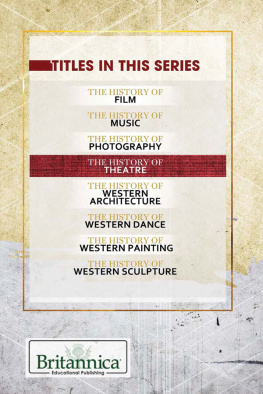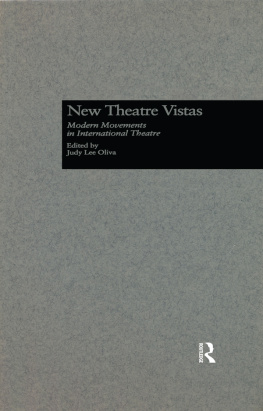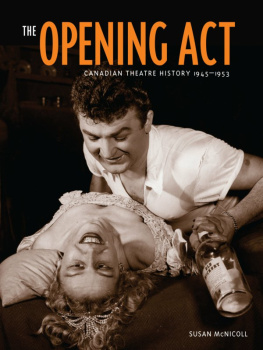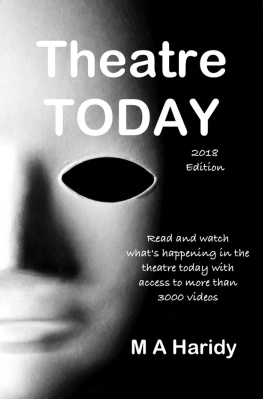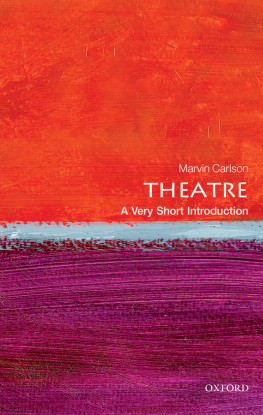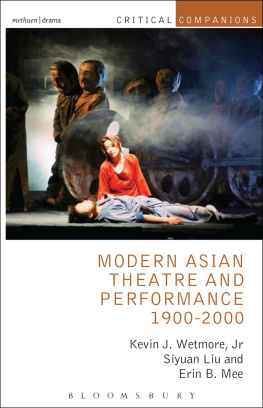JAPAN'S MODERN THEATRE
A CENTURY OF CHANGE AND CONTINUITY
First published 2002 by
Japan Library
Published 2013
by Routledge
2 Park Square, Milton Park, Abingdon, Oxon OX14 4RN
711 Third Avenue, New York, NY 10017 USA
Routledge is an imprint of the Taylor & Francis Group, an informa business
Brian Powell 2002
All rights reserved. No part of this publication may be reproduced, stored in a retrieval system, or transmitted in any form or by any means, without prior permission from the Publishers in writing, except for the use of short extracts in criticism.
British Library Cataloguing in Publication Data
A CIP catalogue entry for this book is available from the British Library
ISBN 978-1-87341-030-1
ISBN 978-1-315-07320-0 (eISBN)
To my many mends in Japanese theatre (several now, alas, deceased) who have helped and inspired me over the past forty years.
Some excellent work in introducing and assessing certain aspects of modern Japanese theatre has been done by the small number of Western scholars working in the field. Over the past forty years or so students of modern Japanese theatre who read English and other European languages have been well served by a number of specialist works. J. Thomas Rimer's introduction of important playwrights such as Kishida Kunio, David Goodman's work on the little theatre movement of the 1960s, and Jean-Jacques Tschudin's studies of kabuki since 1868 and proletarian theatre are three examples (roughly in chronological order) of how areas of this largely unknown territory have been mapped in the recent past. (Rimer 1974; Goodman 1986 and 1988; Tschudin 1989 and 1995) Donald Keene brought modern Japanese plays within the purview of students of literature by giving substantial space to drama in Dawn to the West. (Keene 1984) The availability of doctoral dissertations through University Microfilms has brought more knowledge to students fortunate enough to study at a university where the libraries have the will and resources to buy them. In this context one can mention Eric Gangloff's pioneering study of Kinoshita Junji, Carol Sorgenfrei on Terayama Shji, David Goodman on Satoh Makoto, and many more. The Asian Theatre Journal, with its frequent articles on modern Japanese theatre and its translations of modern plays, has played a pivotal role in encouraging scholarly work in this field, and from time to time theatre journals of more general scope have included work on Japan. The main journals of Japanese studies have also occasionally included articles on this subject.
General surveys and outline histories of modern theatre are few, however, and so far have been confined to the concluding chapters of books which give most attention to the abundant classical heritage. (Kawatake and Kubota 1963, Ortolani 1990) This book accords well-deserved priority to the also abundant theatre of modern Japan. It is an attempt to pull some of the strands together and give them a brief historical context. It focuses on theatre in Japan which has encouraged new playwriting and developed new dramaturgy. Thus, the rise and progress of new genres such as shimpa and shingeki have been described, together with the classical genre kabuki , for which the volume of new playwriting in the twentieth century was remarkable. The relatively few plays assessed here were chosen mainly for their importance to Japanese theatre history as performed drama.
The narrative starts in 1868 at the time of the Meiji Restoration, but it by no means claims to encompass all theatrical activities in the hundred years after that. Such has been the variety of theatre during the modern period (generally defined here as from 1868 to the present day) and so huge has been the number of people involved in it and the number of plays written for it that a short book would rapidly become a list of names. One senses occasionally in secondary Japanese sources the dilemma that the writer has had to face in selecting what is significant to describe. There are often simply too many facts that must be mentioned and while the resulting lists of, for example, new plays or interesting productions are useful for the theatre historian, they would seriously interrupt the narrative of a brief book such as this.
Secondly, it has been necessary to restrict the focus of the narrative mainly to Tokyo. In the world of kabuki there has always been some movement between Edo/Tokyo and the Kansai region (the area in the west of Japan which includes the theatre centres of Osaka and Kyoto). Sometimes these have taken the form of the triumphant progress of an actor who has conquered one area's theatre proceeding to the other; alternatively an actor who has fallen on hard times in one place has gone to the other in the hope of reviving his fortunes. Both have happened in modern genres too. As we shall see, in 1917 an actor called Sawada Shjir, who was trying to establish a new form of theatre, went to Osaka when his first venture failed in Tokyo. Having achieved great popularity in Osaka Sawada returned to similar acclaim in Tokyo.
While this and a few other such cases have left their mark on the development of theatre in both Kansai and Tokyo, on the whole in the modern period Tokyo has been in the forefront of theatrical development and has enjoyed the resources and cultural ethos to sustain new forms. Books on pre-modem Japanese theatre have to pay close attention to what happened historically in Osaka and Kyoto. The new theatre or shingeki movement of the modern period, however, was almost entirely a product of metropolitan culture, and the theatre history of post-1868 Japan was to some extent shaped by the interaction between shingeki and kabuki. Thus for a number of reasons the focus here will inevitably be on Tokyo,
It is also inevitable that there will be many omissions in a narrative that is as compressed as the one presented here. Such omissions may also reflect the author's background in Japanese theatre, both as a spectator and a researcher, and I might here beg the indulgence of the reader as I explain what my own background is. It is practically impossible in Japan to acquire a recognised expertise over the whole range of theatre, as there is simply too much of it. It requires great dedication to become a specialist just in one of the main classical genres and only a few Japanese critics in the last half century have been able to review across genres with equal authority. While I have watched and read about all the types of theatre that I mention in this book, I have not devoted enough time to any one of them to be able to claim status as a specialist.
My earliest work was on modern left-wing drama of the 1920s. (Powell 1971) This was an extreme example of a modern genre which had arisen from a clash with classical theatre and seemed then to have acquired a momentum of its own. It was a source of some surprise to me how rapidly new types of theatre (in this case, first modern theatre - shingeki - and then 'proletarian drama') acquired their own conventions and committed themselves to them. I began to look at people and organisations that stood apart or at least left a definite mark on the environment within which they had begun to operate. An early actress and a maverick kabuki company came into that category. (Powell 1975b and 2001) Latterly, I have concentrated on two playwrights who both conformed to and reacted against the theatrical conventions within which they led their creative lives. One worked in kabuki and is best known for plays which presented a severe challenge to the actors (Powell 1990) The other worked in modern theatre and found that his highest cultural expression needed the combined talents of actors from both the modern and the traditional theatres. (Kinoshita 2000)


